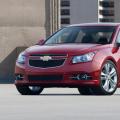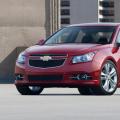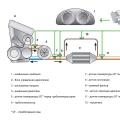Camber must be done for several reasons:
- the first - the car, after adjusting the camber-toe-in, will have better directional stability, that is, the car will not be sidetracked;
- the second - the car will be easier to control, it will become more maneuverable and less prone to drifts;
- the third - having the correct camber-toe parameters saves fuel and increases tire life.
- What does caster, camber and toe mean?
Caster (Caster) - helps stabilize the front wheels in the direction straight motion If this angle is violated due to an impact (for example, into a curb), as a rule, the subframe (beam) or the lower suspension arm is deformed.
Camber - contributes to correct position a rolling wheel when the suspension is in use. The camber is adjusted by loosening the bolts on the struts. In this case, the steering knuckle together with the wheel moves in the directions of the arrows as shown in the figure - therefore the camber angle either increases or decreases.
Toe-in - contributes to the correct position of the steered wheels at different speeds and angles of rotation of the vehicle. Toe-in is regulated by changing the length of the side steering rods by twisting the rod into the tip.
What is better to pump or not to pump the pressure in the wheels?
Low pressure tires reduce handling, increase braking distanceslead to increased wear on the outer edges. At the same time, at the turn to high speed tires can fly off the disks, such cases have happened in my practice. Tires with high blood pressure reduce traction, reduce vehicle stability when braking, lengthen the braking distance, impair handling and wear along the middle edge. Severely inflated tires can "explode" if dropped into a pit. So choose for yourself which is better ...
Why is the steering wheel crooked when driving in a straight line?
If, in addition to the tilt of the steering wheel, there is a side shift on the car at the same time, then first you need to find and eliminate the cause of the steering, and then look at the true position of the steering wheel.
Possible reasons:
1. Increased free run in the steering gear.
2. The vehicle has some displacement of the rear axle (rear axle) or deformation of the rear beam. Especially when one wheel has positive camber and the other negative.
3. Malfunction of hydraulic or electric power steering
4. Big difference in wheel pressure on one axle.
5. There are hidden defects in the chassis, which for some reason were not detected before the camber adjustment.
6. Possible rubber defects. You need to swap the right and left wheels if the steering wheel changes its
7. position in mirror image - flip the tire on one of the front wheels.
The car is pulled to the side, and camber adjustment is not provided, is there anything you can do?
Camber-toe adjustment on vehicles with Macpherson suspension is carried out by struts. If the holes on the struts are oval, then the bolts are loosened and the steering knuckle moves together in the wheel at a given angle. But on many cars (Mitsubishi, Nissan, Hyundai, Kia, etc.), the camber angle is not adjustable, since the holes on the struts are round, not oval. In this case, you need to bore holes and adjust camber.
As a rule, this problem has to be solved in this way on cars with a right-hand drive, the camber angle on which is "set" to the left slope of the road, or on cars with deformed swivel fists... Unfortunately on opel vectra, ford, peugeot and some other cars this is not possible. On such cars, the strut and fist are one.
Why does the car move to the right or left when braking?
If the car drifts to the side when braking, you need to check the car's braking system. As a rule, the cause of withdrawal is air in brake system or a faulty brake cylinder on one side. First you need to pump the brakes, if this does not help, check brake cylinders... If when you press the brake pedal, the pistons of the cylinders do not come out or, on the contrary, do not "release", or there are traces of leakage brake fluid, then the cylinders are defective.
Another reason for the vehicle to slip to the side during braking can be a large difference in wheel alignment. If the camber and caster angles are severely violated, and with opposite signs, then the steering wheel can turn towards a smaller caster angle when braking. But when driving in a straight line, the car does not take away due to compensation of one corner by the other, that is, because of the camber it pulls in one direction, and because of the caster in the other, the angles are balanced - the car drives smoothly.
Why does the car pull (lead) to the right during acceleration?
The drift of a front-wheel drive car can be if there are spacers on the front springs (or on 2109 racks from 2110), and it will pull towards a longer drive (the axle shafts begin to work at an angle, and on a long drive the centrifugal force vector will be greater). In this case, the drift is felt during acceleration, but not with straight, uniform movement. On domestic VAZ 2108 - VAZ 2115 right shift is set "by default". This can be influenced by changing the longitudinal inclination of the rack (castra). Those. on the right, you need to pull out one, and sometimes two washers, or put the same amount on the left. On many foreign cars (VW, Mazda, Ford), to compensate for this effect, the manufacturer puts a damper on the axle shaft.
Why does the car drift aside after toe-out?
1. Check the effect of the rubber on the slip. To do this, swap the left and right front wheels. If the drift changes its direction, then the reason is in the rubber. Go to the tire shop and change one of the front wheels backwards, i.e. so that inner side became external. If the tires are directional, then you can swap the wheels for a while to check if the problems are in the tires. If this is indeed the case, then change the wheels with the rear ones and look for a pair on which the car will go smoothly. This reason for withdrawal has recently been encountered very often (and, not surprisingly, even on imported rubber). The problem is in the quality of manufacture. - these are violations of the tire carcass, as a result of which various elastic deformations occur (roughly speaking, rubber is softer on one side than on the other). By the way, steering wheel beating can occur for the same reason.
2. Increased wheel imbalance. Curvature rims - balance or replace the discs.
3. Only the front axle of the vehicle was diagnosed and adjusted. Need to check rear axle... Perhaps the reason lies in it (deformation of the data, violation of the adjustments).
4. There are hidden defects in the chassis that were not found before the camber adjustment.
Before the adjustment, the car did not go anywhere, there was strong rubber wear. After adjusting the "camber-toe" there was a sideways shift.
Most likely the reason is the rubber (see paragraph above). The car used to drive exactly because the slip created by the rubber was counterbalanced by the slip created by the wrong camber angles to the other side. Eliminated this reason - there was a withdrawal.
The car does not drive and the protector does not "eat", but the car is tight in control ("tight" steering wheel).
1. During repairs, tight joints of ball bearings and steering rods are installed, the pendulum or steering gear is tightened ( steering rack). Over time, the hinges will become lighter when grease gets into the joints (unless of course there is grease). If there was no grease under the anthers, the hinge will squeak.
2. Incorrectly adjusted "camber" (camber angles are the same, but too large).
4. Low tire pressure (pressure less than 1 atmosphere).
Problems 2,3,4 - an increase in the contact patch with the road - as a result of "tight steering".
Why, over time, the wheel alignment angles on the car are violated, even if there was no repair of the chassis and the car did not get into emergency situations?
1. Probably everyone knows that the wheel alignment angles directly depend on the vehicle's ground clearance ( ground clearance) And the clearance, in turn, has a tendency to decrease with the age of the car. This is due to the subsidence of elastic suspension elements: springs, rubber bands, body elements.
2. The appearance and accumulation of microscopic gaps in the hinges of the suspension, which fold together, give tangible changes in the angles.
3. Natural aging of the body (for vehicles with monocoque body), in view of the fact that it experiences constant bending and torsion moments during operation, which leads to a gradual change in its "geometry" and, in turn, to a change in the camber-convergence angles. For example, on new Zhiguli longitudinal tilt the kingpin (caster) is set at 3.5-4 °, but after 2-3 years this figure will be 2-2.5 °. By the way, the same trend is visible on all cars, regardless of the manufacturer, the difference is only in the angles.
For a person who has been driving a car for a long time, this question is inappropriate. Since anyone who has driven a car with a normally adjusted camber at least once in his life, he will feel the car better on the road and the slightest deviations from the normal angles, because the driving pleasure is not the same. A person should rest while driving and receive only positive emotions from driving a car. UUK (wheel alignment angles) were invented by the designers for this, so that you and I can fully feel comfortable on the road and, most importantly, safely, to get a feeling of complete control over the behavior of the car.
A car with normal UUK has :
1.good directional stability (deviations from rectilinear movement should be minimal)
2.easy handling
3.maneuverability
4.Less tendency to skid and roll over in extreme situations
5.good roll forward
6.fuel saving
7.Maximum tire wear resource, etc.
Vehicle with severely disturbed UCC
on the contrary, it can put a "pig" on you at any moment. For example, when driving on dry asphalt, everything seems to be fine, but if you suddenly get on a wet or slippery section of the road, your car may suddenly "want" to go where you would not want at all. The car constantly has to "catch" (adjust) on the road. At the same time, it becomes a constant factor of increased risk not only for the driver, but also for the surrounding cars and pedestrians.
Have you ever thought about the scanty lines of accident reports, which often contain phrases like: "... I lost control of the steering, I found myself on oncoming lane roads ... "etc.? I tend to think that in most cases this is a consequence of improperly adjusted car suspension.
In civilized countries, the UCC check is included in the list of mandatory measures when passing instrumental control. And we have only CO, brakes and headlights.
I would like to touch upon one more important point... When buying a used car (preferably before making a deal), I recommend checking it for the "geometry" of the chassis. it's no secret that most of the cars brought in from abroad for sale are broken in the past. And the appearance is often deceiving. Why not see enough. There are cars welded from two parts (face - from one, back - from the second), and not in the best way, etc.
The main criteria indicating the need to check the Wheel Alignment Angles (CCA) on the car .
1. After the repair of the chassis:
- replacement of steering rods
- replacement of ball joints
- replacement of the pendulum arm
- replacement of the steering gear or steering rack
- replacement of suspension arms
- replacement of silent blocks and springs (re-check is required after 2-3 t.km of run)
- replacement of shock absorbers (because when switching from oil to gas and vice versa, the vehicle clearance changes, which entails a change in the UCC)
2. After carrying out work to change the vehicle clearance (precipitation):
- Installation of spacers or thickened rubber bands under the suspension springs.
- installation of shorter or higher suspension springs.
- change in ground clearance associated with the replacement of oil shock absorbers
to gas and vice versa.
3. There is a slip or the rudder has changed its position while driving in a straight line.
4. "Curved steering wheel". The steering wheel has a strong inclination to one side or the other when driving in a straight line.
This is especially true for vehicles equipped with electronic systems Exchange rate stability.
5. The car does not hold the road well (prowls)
6. The car is "dumb" in management. Reactions to steering movements are belated. Tight or too light steering wheel.
7. When braking, the car pulls to the side or tends to turn on slippery road (in the absence of a brake system malfunction)
8. In case of a hard hitting obstacles, accompanied by the curvature of the disks, the breakdown of the suspension to the stops (even if there are no obvious signs of the above, you need to at least check)
9. Increased wear of rubber.
10. If you have a different turning radius to the left and to the right and you want to align it (sometimes this is accompanied by wheel flaps for the wheel arch liners when the steering wheel is turned all the way)
11. Poor self-return of the steering wheel when exiting a turn.
12. After running in a new car or if you recently bought a used car.
13. The mileage between the planned CP is about 15 thousand km.
I would especially like to recommend to car owners who have very little driving experience, who recently sat behind the wheel of their car, be sure to check the "similarity disorder".
Lack of sufficient driving experience does not allow adequately assessing the quality of the car's behavior on the road,
as a result, a person "gets used" to his car and it seems to him that everything should be as it is at the moment.
"Enlightenment" comes only when, for some reason, you still have to go to a high-quality "Retreat-collapse". How much the car can be more comfortable to drive and more stable on the road becomes truly a revelation for a beginner.
BREAKING-CONVERGENCE
Every car needs preventive maintenance for safety reasons. In particular, we are talking about wheel alignment. These are the wheel alignment angles that affect the vehicle's handling. Correct adjustment similar collapse also has economic significance. It has a direct effect on fuel consumption and also on the degree of tire wear.
Despite the fact that these two terms "camber" and "toe" are always mentioned together, they have different physical meanings. These terms refer to the operations of adjusting and tuning the vehicle's suspension. The essence of these operations is to install correct angles axles of the steered wheels, as well as wheels of the rear multi-link suspension car.
Collapse is the angle between the plane in which the wheel rotates and the vertical. A negative value is the inner directionality of the upper side of the wheels. A positive value is external orientation. When the roll of the vehicle changes, the camber changes.
If you look at the front of the car on which the camber angles have been set, the wheels on the front axle will be deflected outward at an angle of up to 2 degrees from the vertical.
If you put the wheels in parallel, the steering wheel will be much more difficult to turn. This effect is clearly visible on cars without power steering.
If the top of the wheel is tilted towards the center of the car, then camber is negative, if outward it is positive.
Camber changes as the roll of the vehicle changes. Visually, this can be seen in heavy trucks "Tatra": there is such a large camber on an unloaded vehicle rear wheelsthat the car runs only on external tires.

Convergence - the angle between the plane in which the wheel rotates and the direction of movement of the vehicle, in other words, the difference in distances between the rear and front edges of the wheels. Has the most tangible impact on tire life.


Master -the angle between the vertical and the projection of the axis of rotation of the wheel on the longitudinal plane of the vehicle. Responsible for the self-alignment of the steering wheels due to the speed. In some cases, changing the factory value will result in a more consistent straight-line motion.
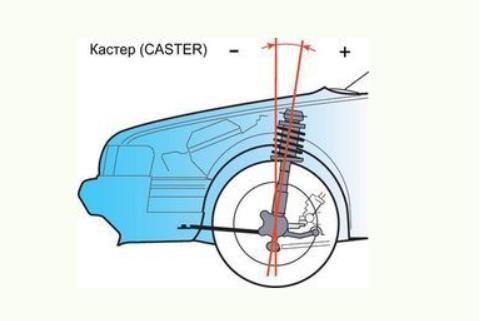
Even a serviceable car suspension needs constant monitoring of its correct adjustment. It is recommended to check the correctness of the wheel alignment angles at least once every 5000 km. mileage and after each tire change. This is not only a serious aspect of your safety, but will also allow you to always prevent increased wear of your car's tires.
Why is wheel alignment so important?
First, to improve directional stability so that the car does not drift to the side (release the steering wheel on a flat road and you will understand what it is about).
Secondly, for easier machine control, increasing maneuverability, reducing the tendency to skid.
And, thirdly, so that the car "does not eat rubber."
By maintaining the settings specified by the manufacturer, you make your machine safer and easier to operate. Weak or inaccurate steering response or tight steering may be caused by misalignment. Properly adjusted camber can save you money!
Misalignment significantly increases tire wear, increases fuel consumption and dramatically accelerates wear on other suspension assemblies. For example, if the angles are set incorrectly, then in a month you can "kill" absolutely new tires, because due to friction, it will strongly wear out in one place.
A car with severely disturbed wheel alignment angles can let you down at any time. For example, when driving on dry asphalt, everything seems to be fine, but if you suddenly get on a wet or slippery section of the road, your car may suddenly go where you would not like at all. The car constantly has to be "caught" (adjusted) on the road.
At the same time, it becomes a constant factor of increased risk not only for the driver, but also for the surrounding cars and pedestrians. Have you ever thought about the scanty lines of accident reports, which often contain phrases like: "... lost control of the steering, found myself in the opposite lane of the road ..." etc.?
In most cases, this is a consequence of incorrectly adjusted wheel alignment angles. In all European countries, wheel alignment check is a mandatory item when carrying out a mandatory technical inspection.
7 reasons to make similar collapse:
- If you "caught" a big hole on the road and jammed the wheel
- After repair of the chassis (for example, replacement of steering tips and rods, suspension arms, silent blocks)
- When changing the ground clearance of the machine (for example, installing inserts, shortened springs)
- If the car began to drift aside
- When relatively new rubber is heavily worn
- When the steering wheel does not return well to the desired position when exiting the turns (when you, after turning, do not unscrew it back to its original position, but simply release it, and it should stand up as it should).
- After seasonal shift tires on a car ("re-shoes" for summer or winter tires).
If you run into a curb or forcefully drive into a deep pothole, you should check the alignment, otherwise you may soon find unusual tire wear (edge \u200b\u200bwear, diagonal wear, lateral warpage) and, as a result, you have to change the tires prematurely!
Causes of control problems, such as blurred steering response, direct direction, a change in direction of movement on an uneven surface, are determined with an indispensable check of the camber.
Fitting new tires or replacing worn out suspension parts is always accompanied by camber adjustment to prevent new tire costs.
Why should you choose our car service to adjust the camber?
- Your convenience. Everything related to undercarriage, can be done in one place: repair the suspension ( undercarriage), make a high-quality "COMBINATION-Camber", "change shoes" and balance the wheels.
- Treating your car as your own. The presence of special wheel "grippers" of increased accuracy for mounting targets on wheels increase the final accuracy of adjustments and guarantee protection Your expensive rims from scratches.
- An eternal and painful theme- car drifts from straight-line movement. Camber is one of several factors affecting vehicle drift. But in any case, we try to determine the cause of the withdrawal and give the owner some advice if the cause cannot be eliminated on the spot.
- Calibrated stand.Za Rulem magazine conducted an experiment. One and the same car was measured by "convergence-collapse" (without adjustment) at several car services. What is the result? Everywhere there are different readings of stands. Why do you ask? We answer: - the stands are not properly calibrated. And whatever sophisticated equipment the car service uses, the issue of high-quality calibration (along with the professional training of the master) is always decisive and remains on the conscience of the persons operating this equipment. We are very jealous of this issue and guarantee that your car is tested on serviceable and calibrated equipment with a 30-day warranty.
- Professional equipment. No manual measurements, tape measures or ropes - only modern equipment! To adjust the camber-convergence, we use the latest computer 3D stand Technovector7 of the latest generation.
Prices
Now let's talk a little about the prices for this service. Let's take one of the most popular cars as an example. Ford - Focus II. Service cost, which includes: checking the wheel alignment angles of the front and rear axles, adjusting the toe angles of the front and rear axles (wheel camber adjustment is not regulated by the manufacturer) is 960 rubles.
Car enthusiasts know that when parts are replaced in the undercarriage, the settings change and, as a result, the behavior of the car on the road changes. The camber geometry depends on rubber wear, chassis backlash, tire pressure and other parameters. To achieve stability of the machine, the front wheels, as well as the rear ones, are placed at a regulated angle relative to each other, the road and body elements. In this article we will try to answer the question - when, in what cases do you need to do geometry (similarity collapse)?
To  structurally, the suspension of most cars has the ability to adjust the camber. This procedure is necessary so that after the completion of the replacement, adjustment of parts, the person behind the wheel of the car gets pleasure from the correctly installed front wheels. In addition, it is one of the important factors that determine traffic safety.
structurally, the suspension of most cars has the ability to adjust the camber. This procedure is necessary so that after the completion of the replacement, adjustment of parts, the person behind the wheel of the car gets pleasure from the correctly installed front wheels. In addition, it is one of the important factors that determine traffic safety.
When developing a project for the suspension of the front and rear wheels, specialists took into account that after each repair or replacement of products of this unit, it is necessary to adjust the tilt angles. The manufacturer has laid down possible deviations from the specified parameters, which have minimum values, expressed in units, fractions of arc seconds. Usually engineers automotive production talk about multiple installation angles.
They have a great, and, more precisely, decisive importance on the dynamics, controllability and economy in the operation of the machine.
Their list is as follows:
- collapse;
- descent (convergence);
- caster, etc.
The first parameter is presented as the angle of inclination of the wheels relative to the roadbed. It can be positive (the upper side of the slope is directed upward and outward) and negative (its upper part is inclined inward). Each of these provisions has pluses and minuses. Correct inclination of the front wheels is necessary to ensure good grip from road surface and stable management.
The toe angle must be understood as the difference between the distances measured at the lower and upper points of the wheels. A sign of deviation from the indicators regulated by the manufacturer is accelerated severe wear, leading to frequent replacement tires and increased fuel consumption. Convergence is measured in millimeters as well as degrees / minutes.
Caster - longitudinal angle kingpin tilt, it is needed to stabilize control and self-align the wheels.
When to adjust toe and camber
 The manufacturer gives recommendations for the implementation of this procedure, they indicate after what value of mileage this should be done. For domestic cars it is needed within 10-20 tons. km, for foreign cars 25-30 tons. km. It is important to remember that even if the car was not in an accident and the chassis elements are not replaced over time, the setting of the angles is violated.
The manufacturer gives recommendations for the implementation of this procedure, they indicate after what value of mileage this should be done. For domestic cars it is needed within 10-20 tons. km, for foreign cars 25-30 tons. km. It is important to remember that even if the car was not in an accident and the chassis elements are not replaced over time, the setting of the angles is violated.
During operation, due to the subsidence of the silent blocks, shock absorber springs and other suspension elements, the parameters must be changed. The appearance of microscopic backlash in the joints leads to the replacement of these indicators. In this regard, experienced motorists adhere to the "golden rule" at least once a year to check the correct setting of the corners.
Extraordinary adjustment of the installation angles (toe, camber) should be done in the following cases:
- when replacing shock absorber struts, stabilizer, ball bearings, spring bearings, steering rods, rack, gearbox and many other chassis parts;
- accelerated tire wear;
- the disc is bent as a result of the impact of the wheel on an obstacle, requires replacement or restoration;
- spontaneous drift of the car to the side;
- changing the ride height parameter by shortening or lengthening the spring;
- replacing tires with tires of a different size;
- at the end of the turn, the steering wheel does not return to its original position;
- at seasonal replacement rubber;
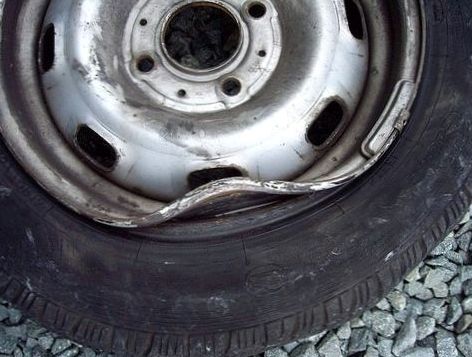 At the same time, when replacing many parts, if there is confidence that the settings have not been knocked down, an experienced driver can be adjusted at will, for safety reasons. Because by car behavior experienced driver will quickly determine the appropriateness of such an adjustment.
At the same time, when replacing many parts, if there is confidence that the settings have not been knocked down, an experienced driver can be adjusted at will, for safety reasons. Because by car behavior experienced driver will quickly determine the appropriateness of such an adjustment.
Why do you need to make geometry when replacing units and parts of the undercarriage?
 This is because the position of the wheels depends on the specified parts. For example, the adjustment was carried out with the old support, which has a certain gap, at the end of the replacement with a new one, there is no play, which means that the angle of inclination is different. It is also necessary to change the steering tips, rods, and the rail, taking into account that additional work will be required to install the angles of the slopes.
This is because the position of the wheels depends on the specified parts. For example, the adjustment was carried out with the old support, which has a certain gap, at the end of the replacement with a new one, there is no play, which means that the angle of inclination is different. It is also necessary to change the steering tips, rods, and the rail, taking into account that additional work will be required to install the angles of the slopes.
Indeed, after replacing the specified parts, all parameters will be violated, and with the help of the tips, the convergence is adjusted. If you do not change the settings, then accelerated tire wear will occur, and controllability will deteriorate. vehicle... When replacing a CV joint, specialists have to disassemble the fastening of ball bearings, bearings, and sometimes steering tips.
At the end of the replacement, the listed products must be put back in place, while there is a high probability that the settings will fail. Which, in turn, leads to the steering wheel being in an abnormal position, the car may spontaneously move to the side. The wheel alignment angle also depends on the ground clearance, therefore, after the replacement of the spring, tires with a different size, the ground clearance parameter will change, which will also require geometry adjustment.
Why suspension geometry
 How to replace the front and rear stabilizer struts with your own hands
How to replace the front and rear stabilizer struts with your own hands

